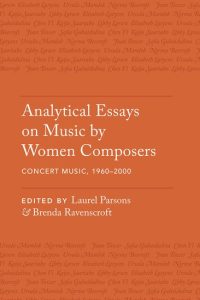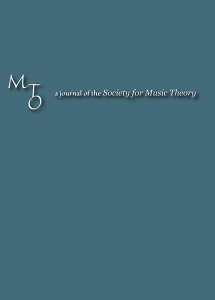Humour in late Debussy: multiple perspectives on “Douze études”
Author: Wong, Lucas Publication details: WONG, LUCAS. “Humour in Late Debussy: Multiple Perspectives on ‘Douze Études.’” The Musical Times 157, no. 1935 (2016): 77–98. http://www.jstor.org/stable/44862507.
Inhabiting or Inhibiting? Physical Expression and Ancillary Movements in Instrumental Music Performance
Author: MacLennan, Scott Publication details:Canadian Music Educator, Vol. 57, Iss. 4, (Summer 2016): 22-27. Weblink: www.proquest.com Abstract: Music theorists have emphasized the intellectual, disembodied mind throughout music education’s history in Western culture extending back to the time of the ancient Greeks. Additionally, Regelski (2009) notes that the dominant and residual view of music curriculum involves […]
This Imaginary Halfe-Nothing
Author: Laurel Parsons Publication details: “‘This Imaginary Halfe-Nothing’: Temporality in Elisabeth Lutyens’s Essence of Our Happinesses.” In Analytical Essays on Music by Women Composers. Vol. 3: Concert Music, 1960–2000 (New York: Oxford University Press, 2016). 196–220. Weblink: academic.oup.com Description: In Essence of Our Happinesses (1968), a three-movement work for tenor, chorus, and orchestra, Elisabeth Lutyens explores the […]
Superposition in Kaija Saariaho’s ‘The claw of the magnolia….’
Author: Roeder, John Publication details: Analytical Essays on Music by Women Composers: Concert Music from 1960-2000, edited by Laurel Parsons, and Brenda Ravenscroft, 156-175. New York: Oxford University Press, 2016. Oxford Scholarship Online, 2016. Weblink: https://global.oup.com Abstract: Kaija Saariaho’s From the Grammar of Dreams, for two solo female singers, elegantly articulates the poetic structure of Sylvia Plath’s […]
Verdi on Stage: Notes on Five Recent Productions
Author: Vellutini, Claudio Publication details: Nineteenth-Century Music Review 13, no. 2 (2016): 392-400. Weblink: https://www.cambridge.org
Dyslexia and Post-Secondary Aural Skills Instruction
Authors: Laurel Parsons Publication details: Aural Skills and the Music Major with Dyslexia.” Music Theory Online 21.4, December 2015. Weblink: mtosmt.org Abstract: Traditional post-secondary aural-skills curricula can create extreme difficulties for music majors with dyslexia. This article places the author’s experience teaching these students into the context of contemporary scientific and educational research on dyslexia, including […]
Music, Bacchus, and Freedom
Author: Law, Hedy Publication details: The Oxford Handbook of Music and the Body, edited by Youn Kim and Sander L. Gilman. New York, NY: Oxford University Press, 2015. Weblink: http://www.oxfordhandbooks.com Abstract: Nietzsche points out in The Birth of Tragedy (1872, rev. 1886) that modern Dionysiac music began with Beethoven’s symphonic music and matured in Wagner’s […]
A Cannon-Shaped Man with an Amphibian Voice: Castrato and Disability in Eighteenth-Century France
Author: Law, Hedy Publication details: The Oxford Handbook of Music and Disability Studies, edited by Blake Howe, Stephanie Jensen-Moulton, Neil William Lerner, Joseph Nathan Straus, 329-344. New York, NY: Oxford University Press, 2015. Weblink: https://global.oup.com Abstract: This essay suggests how cultural histories of the castrato (exemplified by the writings of Giuseppe Gerbino, Roger Freitas, Bonnie […]
Mapping how students conceptualize ancillary movements in instrumental music performance
Author: MacLennan, Scott Publication details: University of British Columbia. Open Collections, UBC Theses and Dissertations (open.library.ubc.ca) Weblink: open.library.ubc.ca Abstract: Music theorists have emphasized the intellectual, disembodied mind throughout music education’s history in Western culture extending back to the time of the ancient Greeks. Additionally, Regelski (2009) notes that the dominant and residual view of music […]
Defining temporal multiplicity in American popular music, 1950-2000: A case study in macroanalysis using multiple bibliographic databases
Author: Poudrier, Ève & Castonguay, Rémi Presentation details: Current Musicology 50th Anniversary Conference, Columbia University, New York City, New York, 29 March 2015 Weblink: http://columbia.edu Abstract: This presentation explores the challenges of assembling a corpus of secondary literature for the purpose of computational analysis working across multiple bibliographic databases. Our multi-tiered search methodology will be described, and […]

